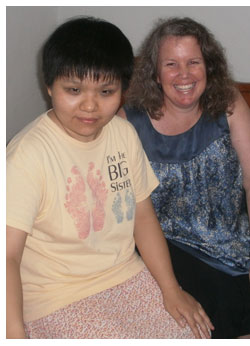Book review: Anna Saldo-Burke’s Green Mittens Covered Her Ears — A Look at Autism
by Patricia Wright
 I love it when people ask how I got interested in autism — it gives me a chance to talk about Shari! Shari has autism, and I provided respite care for her when I was in high school. That experience, and the relationship that developed between Shari and me as a result, was incredibly influential in my life.
I love it when people ask how I got interested in autism — it gives me a chance to talk about Shari! Shari has autism, and I provided respite care for her when I was in high school. That experience, and the relationship that developed between Shari and me as a result, was incredibly influential in my life.
Memories of Shari came flooding back to me when I read Anna Saldo-Burke’s Green Mittens Covered Her Ears — A Look at Autism.
The book is about a high school classmate who had autism, and it served to remind me how crossing paths with someone like Shari (or in Dr. Saldo-Burke’s case, Jessica) can have a profound influence on the choices we make in life. The author is a 27-year veteran teacher in both Special and Inclusive Education classrooms, and she sees the need to create awareness and provide understanding about others who are different.
Saldo-Burke’s short story has wonderful illustrations, and the book gives the reader a strong sense of what it is like to attend high school as a person with autism. It also gives the reader a look at what it’s like to attend high school with a person who has autism. The descriptions of Jessica’s challenges in navigating high school life as a person with autism are enlightening, but what I really appreciated in this book is the way the author describes how much Jessica meant to her. Their time on and off-campus together clearly influenced Dr. Saldo-Burke to go on to work in inclusive education.
Green Mittens is a great short read. It celebrates Jessica’s learning and success in high school and beyond, and it demonstrates how people with disabilities contribute to our society in so many ways.
PS: If you want to read more about Shari, the young woman who influenced my own life in so many ways, you can read a story her dad wrote about her for Fathers Network, a site providing information and resources for fathers, family members, and care providers of children with special needs.







 I am pleased to welcome Julie Smrha, Marketing Coordinator at Easter Seals Capper Foundation, as a guest blogger today. I have visited the Kidlink program in Topeka myself and know firsthand how delightful those preschool children are!
I am pleased to welcome Julie Smrha, Marketing Coordinator at Easter Seals Capper Foundation, as a guest blogger today. I have visited the Kidlink program in Topeka myself and know firsthand how delightful those preschool children are! Last week
Last week 

 I was so sorry to hear that Dr. O. Ivar Lovaas, a respected and revered pioneer in the treatment of autism spectrum disorders, died this week. Dr. Lovaas was 83 years old when he died from natural causes at a Los Angeles-area hospital, surrounded by his family. His son, Eric, will continue his father’s research and treatment, and
I was so sorry to hear that Dr. O. Ivar Lovaas, a respected and revered pioneer in the treatment of autism spectrum disorders, died this week. Dr. Lovaas was 83 years old when he died from natural causes at a Los Angeles-area hospital, surrounded by his family. His son, Eric, will continue his father’s research and treatment, and